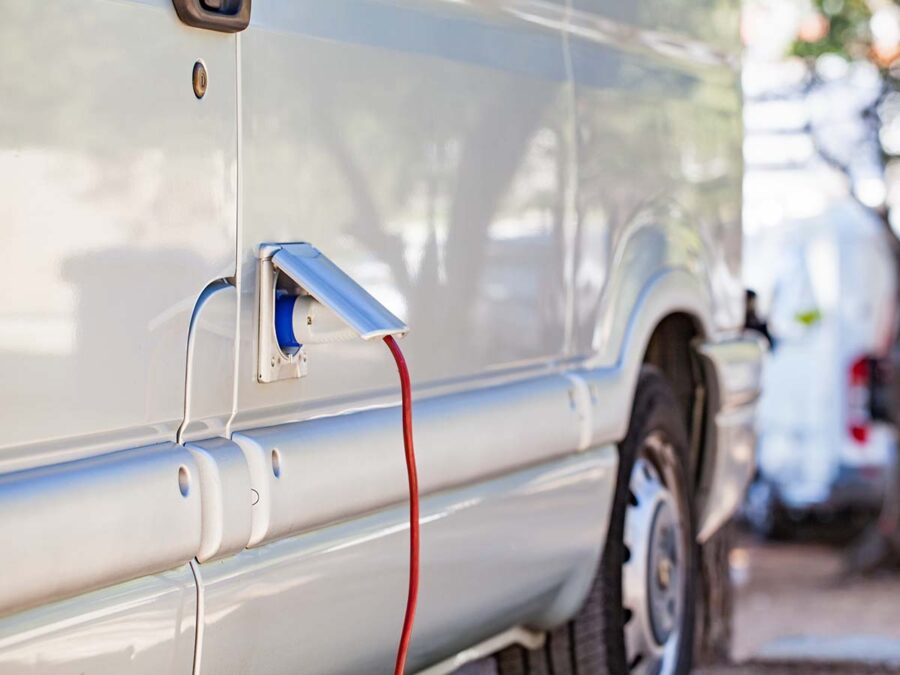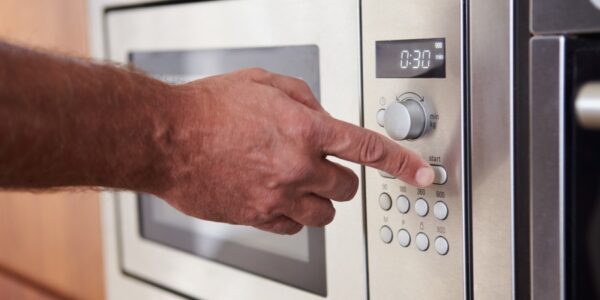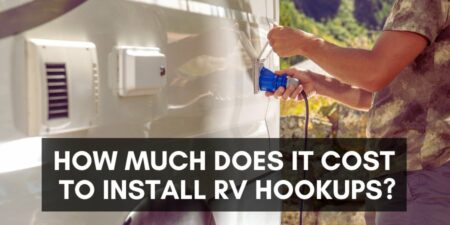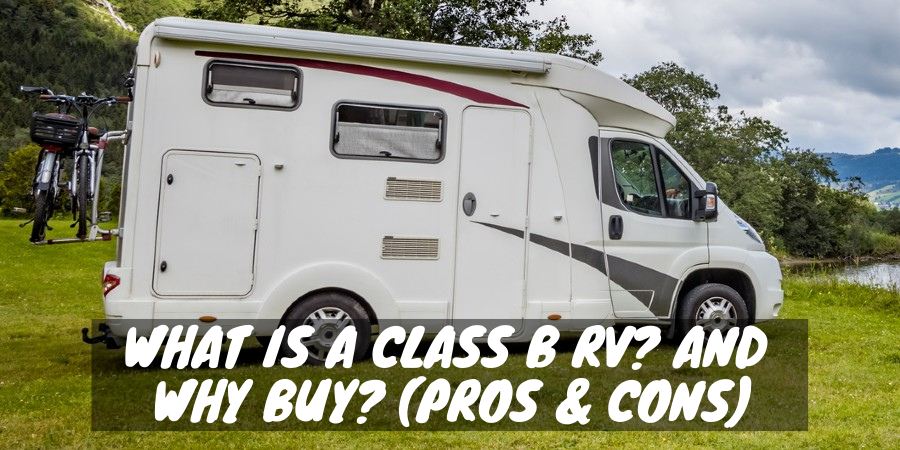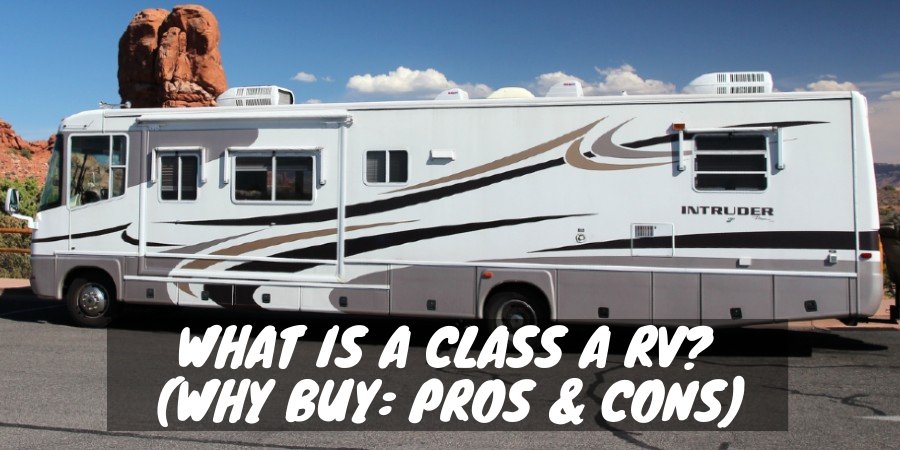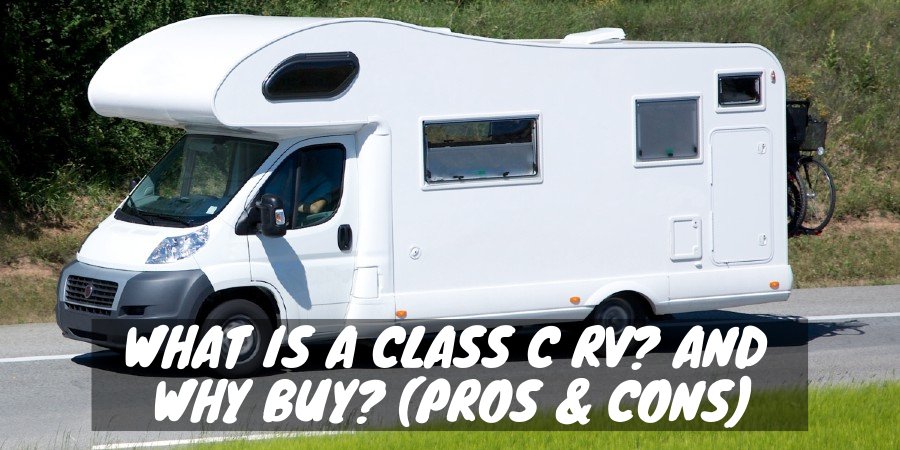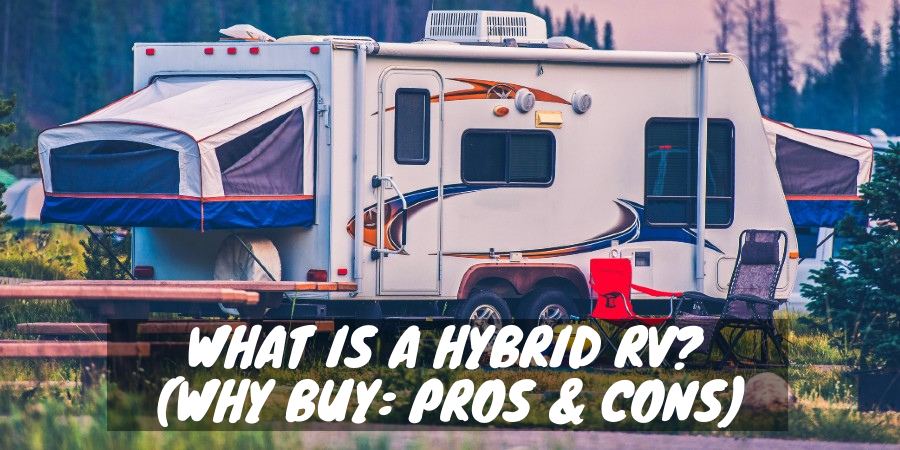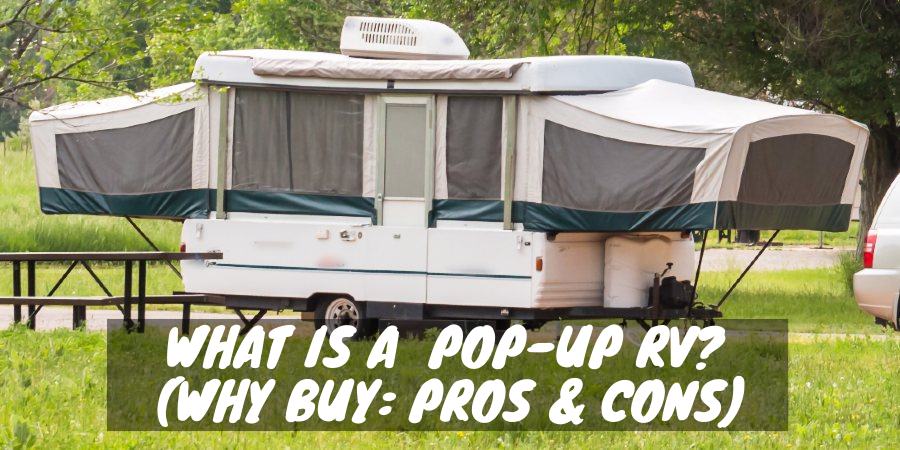People have asked me, are RV electrical hookups easy? New RVers may find hooking their camper to a campground or residential electrical system confusing and a bit scary. No one wants to blow out their RV’s power grid by hooking up incorrectly or using the wrong 30 or 50-amp adapters.
Luckily, we can help you learn the right way to hook up your RV to shore power to avoid electrical issues, and it isn’t hard once you know the steps. We also suggest some of the best surge protectors and adapters to ensure all your RV appliances and devices run smoothly and safely.
Please enjoy this guide that will help you master easy RV electrical hookups so you can set up your campsite fast and start relaxing!
Difference Between 30-Amp and 50-Amp RV Electrical Hookups
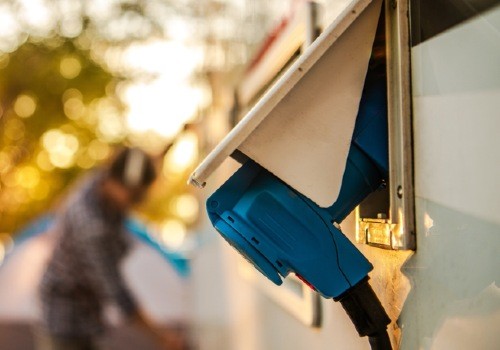
Before jumping into how to hook up a recreational vehicle to power, it’s important to understand the difference between a 30-amp and a 50-amp RV electrical service.
30-Amp RV Power
30-amp service is what you will find in most small to mid-size RVs, especially in older models. 30-amps of electricity translates into 3,600 watts of power, which is typically enough to run essential RV appliances and devices simultaneously.
However, when running any high-wattage-draw appliances, such as an air conditioner or microwave, you can easily blow the electrical circuit because you will exceed the number of watts the 30-amp system can safely distribute.
RVers with 30-amp power quickly learn which appliances they can run at the same time. For example, you can run your AC and your refrigerator, which needs 800 watts to operate, but not your AC and coffee maker, which pulls 1750 watts.
50-Amp RV Power
When it comes to RV electrical hookups, there’s a reason large motorhomes, fifth wheels, and travel trailers (and many new smaller RVs) have 50-amp electrical service, and that is because it offers 12,000 watts of power.
By nearly tripling the number of watts that 30-amps provide, a 50-amp camper can run more appliances and devices simultaneously without blowing any breakers. More power is essential for RVs with two or more air conditioners, which is becoming more commonplace.
There will rarely be a scenario in a 50-amp camper where you overload the circuit. This benefit alleviates the hassle of playing musical chairs with the appliances you want to use while camping to avoid blowing a fuse.
What to Expect Inside a Campground Power Pedestal
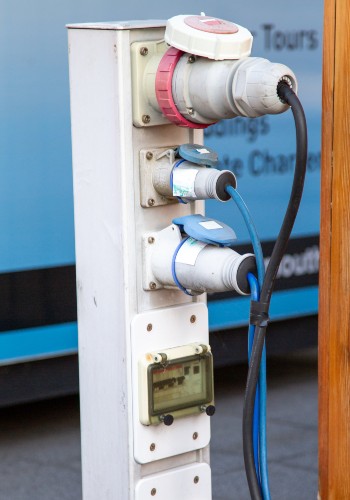
A campground power pedestal looks like a metal box similar to an electrical panel found in residential properties.
The box will be smaller and have a door or cover to keep out the rain. Most campgrounds mount this box to a wooden post about two to three feet tall, set in the ground on the right-hand side, middle to rear of the campsite.
On the inside of the electrical box will generally be two plugs and two breakers, a set each for the 50-amp circuit and the 30-amp circuit. You may also find a 110-volt outlet and cable connection inside the metal box.
However, if you’re visiting a campground that only offers 30-amp service, such as in most state and national parks or older private campgrounds, there will be a single 30-amp outlet and breaker inside the box.
If you have a 50-amp RV, you’ll need to insert a 30-to-50-amp adapter into the outlet before being able to plug in the 50-amp cord for an electrical hookup. There are also 50-to-30-amp adapters available if a power pedestal only offers 50-amp electrical service and you have a 30-amp power plug.
Please note that whenever you need to plug a 50-amp RV into a 30-amp power pedestal using an adapter, you will only have 3,600 watts of power available. This is why it’s helpful to understand the wattage draws of your camper’s appliances and devices, no matter which amperage it is.
Likewise, if you’re in plugging a 30-amp RV into a 50-amp outlet using an adapter, you will not magically have 12,000 watts of power available. Instead, the adapter will safely lower the amperage to the level suitable for your RV’s electrical system.
Steps For Properly Hooking Up Your RV to Shore Power
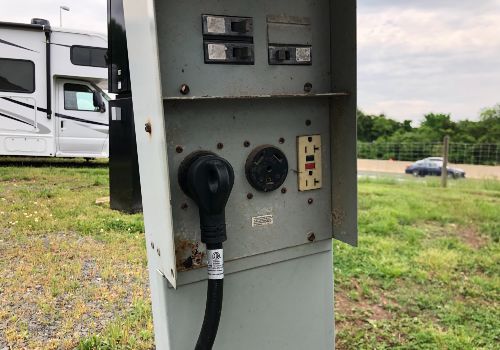
The procedure for campground electrical hookup will be slightly different than when connecting to service at a residence or other conventional 120V outlet. Below, you’ll find the correct procedure for each location.
Hooking Up RV to a Campground Power Pedestal
You’ve finally made it to your campsite and parked and stabilized your RV. Whether you own a motorhome, a travel trailer, RV or a fifth wheel, plugging your camper into an electrical hookup is the next step, along with connecting your water and sewer lines if you plan to use them.
But, before you go willy-nilly pulling out your power cord and running it over to plug into the power pedestal, you must first ensure all your camper appliances are either turned off or unplugged.
Step 1. Turn Off All Camper Appliances And Devices
Most RVers are never taught this valuable lesson on the electrical draw and the damage it causes to a camper’s electrical system if you plug in while appliances are in the “on” position. Too many items pulling maximum amperage to start running as soon as your power plug contacts the outlet will blow your RV circuits and possibly fry wiring or components.
Turning off or unplugging camper appliances before leaving a campsite and double-checking that they are off before hooking up at a new campsite should be a task on your RV set-up and tear-down checklist, so you never forget.
Step 2. Carefully Open And Inspect The Electrical Panel
We must mention that sometimes critters hide or make nests inside campground power pedestals. Bee or wasp hives, lizards, and frogs are common visitors inside the metal boxes, so open them carefully to avoid issues.
Take a close look at the electrical outlets and breakers inside the box. Are they intact and don’t show signs of melting, scorching, or cracks? Are the breaker switches moving firmly from the on to off positions?
If you see something odd about the outlets or breakers inside the box, contact a campground host or office staff immediately so they can fix it or move you to another campsite. You don’t want or need your vacation ruined because you decided to use the box anyway, and you burned up your RV’s electrical system at the hookup.
Step 3. Turn Off The Breaker For Your RV Amperage
Locate the 30 or 50-amp breaker that works for your RV and flip the switch to the “off” position.
It’s helpful to turn off any other breaker inside the box if you won’t be using it. For example, keep the 50-amp breaker off if you will be using the 30-amp outlet. Likewise, if there is a 15 or 20-amp breaker for a standard 110-volt outlet inside the pedestal, only turn it on when you actively use that plug.
Step 4. Plug RV Power Cord Into The Appropriate 30-AMP or 50-AMP Outlet
Now that no power is going to the outlets, you can plug your power cord directly into the power outlet that matches your RV amperage or plug in a surge protector and then plug your power cord into that unit.
Of course, if you need to use an adapter because there’s only one working 30 or 50-amp outlet, insert that before plugging in your RV cord.
A 30-amp RV outlet has three slots. The top will have a small hole for the grounding portion of the plug. The bottom of the outlet will have two angled slots to insert the neutral and hot prongs.
A 50-amp outlet will have a small hole at the top for the grounding prong and three vertical slots that fit the neutral and hot prongs.
It’s physically impossible to fit a 30-amp plug into a 50-amp outlet, and vice-versa, so it should be a straightforward choice when making a connection.
Surge protectors are a must-have RV component that we will discuss in more detail in the products section below. Most RVers who use a surge protector always plug this unit in first to check that the campground’s electrical wiring is correct before plugging in their RV power cord.
Step 5. Flip The Electrical Breaker To The “ON” Position
Once you have the RV power cord or your surge protector plugged into the power pedestal for an electrical hookup, you can now flip the breaker to the “on” position. The indicator lights on the surge protector should be green, which means the wiring is safe for your RV.
Want to Connect With a Community of Over 1,078 RV Enthusiasts?
You should now have power running to your recreational vehicle.
Step 6. Go Into The RV and Turn On The Devices and Appliances You Wish to use
Now, you can enter your RV and turn on or plug in each appliance you plan to use during your camping trip. For example, if you want to cool down your RV first thing, turn on your air conditioner and let it run before turning on other appliances.
Unhooking your RV from Campground Power
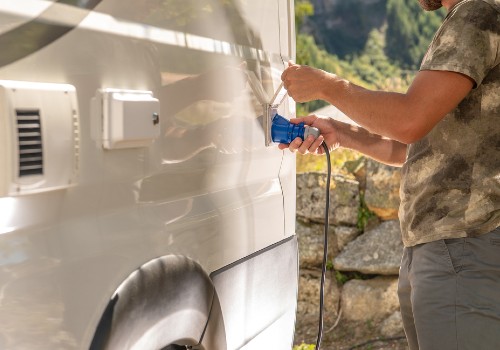
You’ll need to reverse the steps above when leaving your campsite, but the process is much quicker.
First, turn off or unplug all RV appliances and devices, then go outside and flip the breaker to the “off” position. Next, unplug your RV power cord and any surge protector or adapter and store them away.
Campground hosts appreciate it when guests leave the breakers in the off position when they leave. Close the electrical panel’s door or cover, and you’re done!
Hooking Up RV to a 120V Outlet
RV hookup installation at home or another non-campground location with only a 120-volt power source will be necessary sometimes, so follow these steps to do so safely:
- Step 1. If possible, turn off the main breaker to the RV plug-in outlet
- Step 2. Plug a 30 or 50-amp to 15/20-amp adapter to the end of the RV power cord
- Step 3. Plug this adapter into the 120-volt outlet
- Step 4. Turn the breaker back on
- Step 5. Go inside the RV and turn on the lights, water pump, fridge, or other supported appliances
Remember that plugging in an RV directly to a standard 120-volt outlet on a 15-amp circuit will only provide your camper with enough electricity to operate 15 amps’ worth of appliances or devices.
This amount of wattage may be enough to run your air conditioner and a light or two, but not much else before blowing the breaker to the circuit.
Best RV Surge Protectors and Electrical Adapters
We can’t express how often a surge protector has prevented major RV appliance damage, frying sensitive electronics such as a laptop computer, or even an electrical fire.
RV Surge Protection and Essential Electric Adapters (Video)
Never skimp when purchasing an RV surge protector and any of the different RV power adapters necessary to be ready for any electrical hookup situation. A quality product will ensure your RV’s electrical flow is reliable and safe and save you from expensive repairs to your RV electrical system.
Best RV Surge Protectors
Surge protectors come in 30-amp and 50-amp models. Check out these top-rated brands of surge protectors that will save your RV from uneven power flow or faulty electrical wiring:
- Progressive Industries EMS-PT30X
- Power Watchdog Surge Protector with Bluetooth HU27FR 50A
- Southwire Portable Surge Guard Protector, 50 or 30-amp
The best surge protectors will indicate open ground or open neutral wires, other incorrect wiring issues, low voltage, and automatic shut-off for power surges.
Best RV Power Adapters
Every RVer should carry a 30-to-50-amp, a 50-to-30-amp, and a 50 or 30-amp to 15/20 amp adapter in their camper. Here are the top brands that deliver quality RV power adapters:
- Camco 55233 Electrical Powergrip Adapter 30A to 15A
- ClearMax Dogbone Electrical Adapter with Handles 50A to 30A
- Getwired RV Electrical Power Cord Plug Adapter 30A to 15A
- MicTuning Dogbone Electrical Adapter 30A to 50A
RV Electrical Hookup Wrap-Up
Learning how to hook up your RV to electricity is easy when you understand the steps and the reason for doing it in a specific order.
A recreational vehicle is a big investment. Protect it by following the steps to connect your camper to shore power and using only the best surge protectors and adapters available so every camping journey goes off without a hitch!
"Man cannot discover new oceans unless he has the courage to lose sight of the shore."
-- Andre Gide

